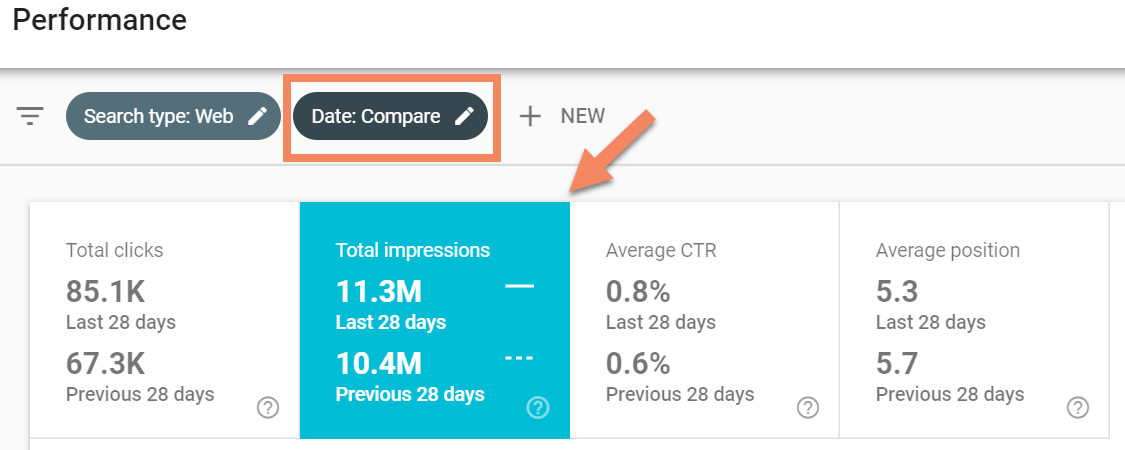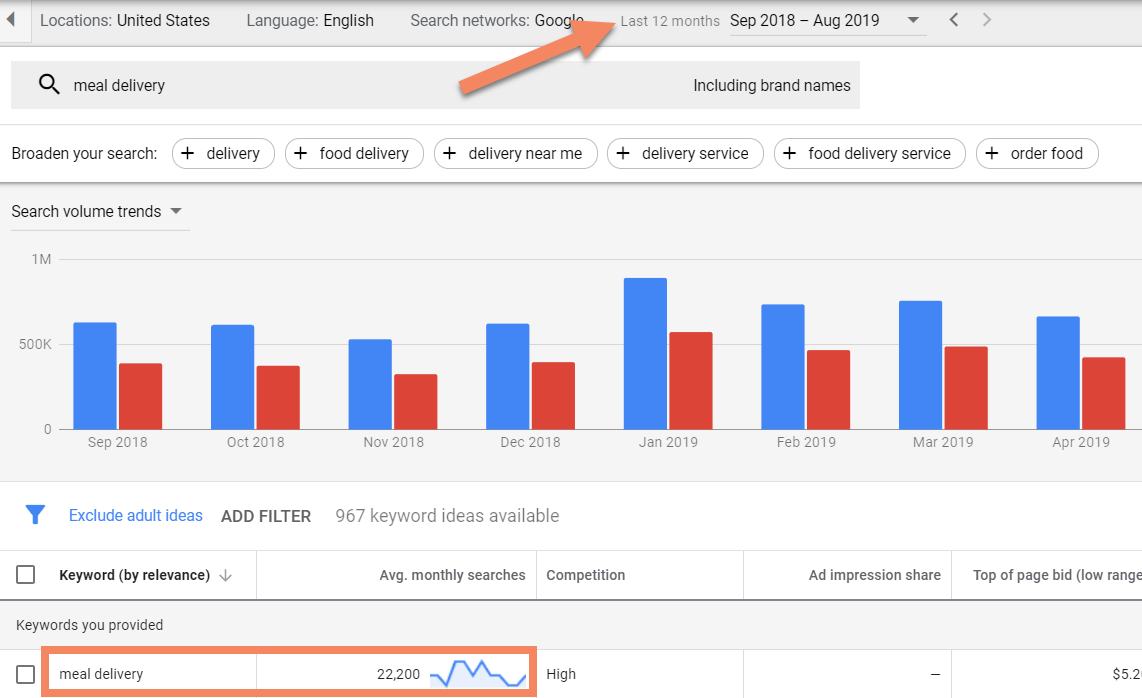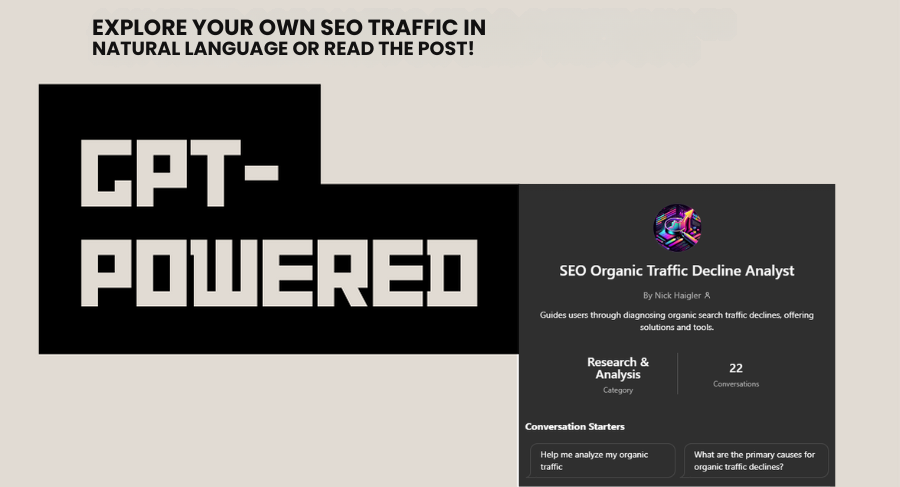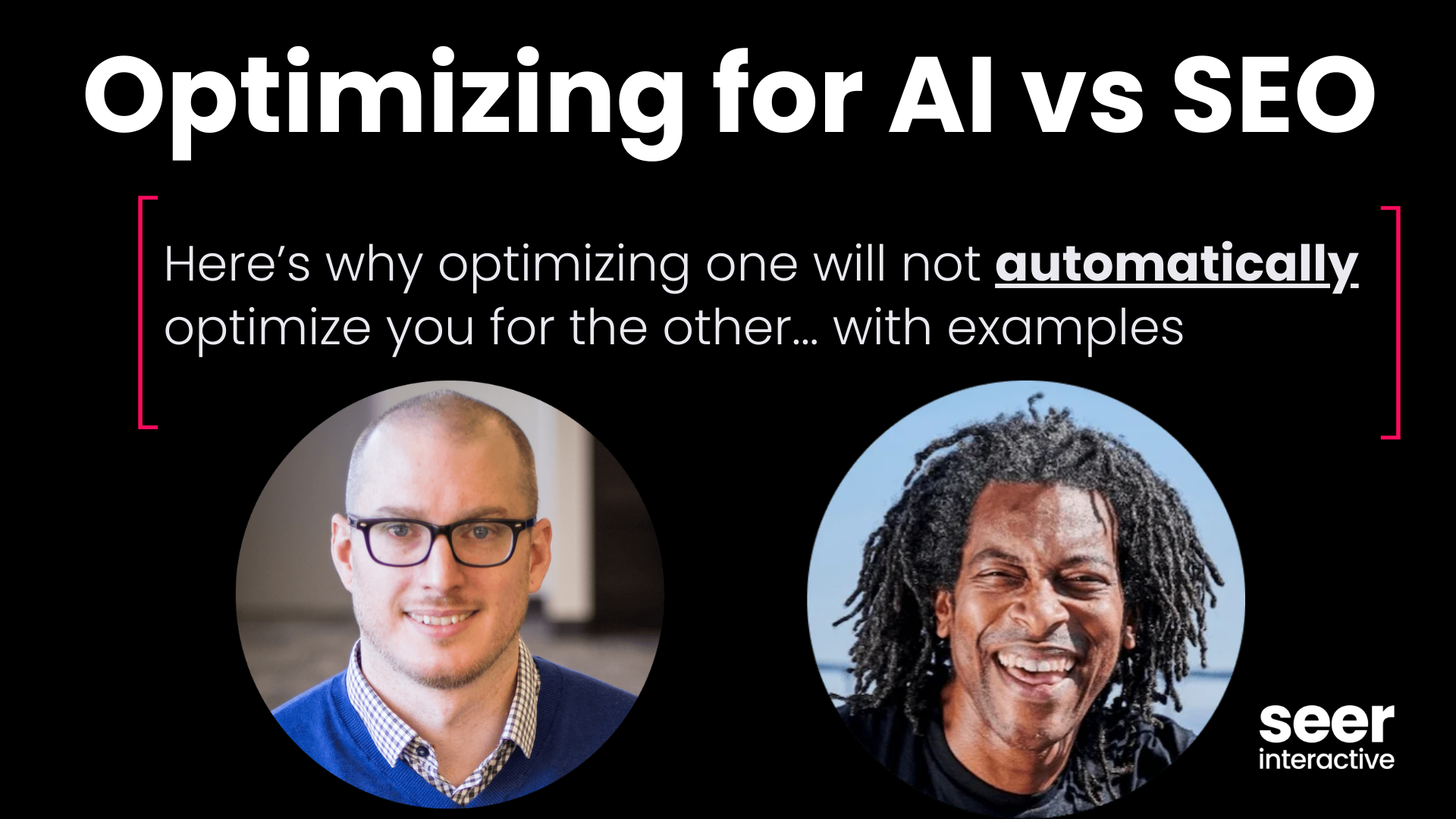Use the ChatGPT powered version in the GPT Store!
This post was originally published in 2019, and last updated October 2021.
Being able to determine the cause of an increase or decrease in traffic is a priceless skill. It allows you to anticipate declines and pivot your SEO strategy to prevent downward shifts, but also helps you identify wins as a result of the fantastic SEO work you’ve done! 🎉
In this post, you'll find a list of common causes that can explain why organic traffic might be trending up/down (& what you can do about it):
Common Causes of Organic Traffic Decline (& How to Check if it's Happening to You!)
Seasonality
Seasonality refers to anything that may cause a change in the number of users searching for the topics your site covers. There are three main ways to determine if seasonality could be a contributing factor in your traffic performance:
✔ Compare Organic Traffic Year Over Year
Using Google Analytics, you can easily compare the date range where you’ve noticed a traffic fluctuation to the previous year. If you don’t see a similar trend as last year, seasonality may not be a factor and something else is likely at play.
However, if you do see a similar fluctuation, then it’s likely you can chalk this traffic change up to seasonal factors.
✔ Compare Search Demand
Using monthly search volume from Keyword Planner and search impressions from Google Search Console, you can determine if there are more or less users searching for topics your site covers for a specified time period.
- Google Search Console Search Impressions – Set your comparison date range, navigate to the site section that saw a fluctuation in traffic, then compare impressions pre and post. If impression volume is different, you could be looking at seasonality.

- Keyword Planner Monthly Search Volume – Set your date range for the current month, enter a keyword (or a few) that you’re confident drives traffic to the page or pages you identified as experiencing a traffic fluctuation, note the MSV estimate, then compare to a different date range. If the two MSV estimates are drastically different, seasonality could be the culprit.

Increased Competition
Sites publish tons of new content online every day. There’s a good chance that increased competition (i.e. new, better content 🙄) is outranking you, resulting in traffic declines. There are a few ways to confirm this using data, all of which are primarily focused on a close review of page one of the search results page:
✔ Compare Click-Through-Rate (CTR)
Using Google Search Console, you are able to compare your CTR for two time periods. If you see that your CTR plummeted when your traffic decreased, it’s time to take a look at your competition – but we don’t just mean your direct competitors.
Keep reading to learn what we mean by this or learn how to calculate your own CTR curve to better determine which keyword ranking position changes will have the greatest impact on your traffic.
✔ Compare Competitors
Using a keyword tracking tool like STAT or SEMRush, take a quick look at who ranks where on page one for your target keywords. Can you identify any new competitors that weren’t outranking you before? In some instances, your page’s rank might not even change, but this new competitor has snuck in and replaced one of the sites ranking higher than you.
Depending on the domain, what they offer, and how enticing their meta data is, their presence could be stealing clicks from your organic listing. If this is the case, take some time to identify what they do well and test how you might be able to emulate it for your benefit.
✔ Compare SERP Feature Presence
If your competitors haven’t changed, it’s time to take a look at the SERP landscape. Are there new answer boxes, People Also Ask queries, paid ads or shopping carousels? If so, your CTR could be suffering even if your rank remains constant.
In this instance, it’s best to re-evaluate how much traffic you can actually earn and consider investing in less competitive keywords with less crowded SERPs.
Decreased Visibility (Keyword Ranking Shifts)
As SEOs, this is one of the first places we look when we see a traffic decline. If rankings decreased and so did traffic, we typically mark this case as solved and set out on a journey to reclaim those rankings.
However, with over 200 different ranking factors, there’s much more than just rankings to look at to help us get closer to the root cause of a traffic decline.
✔ Compare Competitors
Yes, we know we’ve already covered competition as a potential cause, but this time we’re talking about when a competitor used to rank below you, but improved their ranking position, pushing yours further down. This can be confirmed via STAT, SEMRush or other keyword tracking tools.
If you find this is the case, it’s time to do a deep dive on their content to determine why Google has determined it’s a better match for users than yours.
✔ Compare Branded Rankings
- Branded rankings declining abruptly
- Branded keyword rankings can be easily forgotten, but are an integral piece of the puzzle when trying to sort out why traffic is down. If you’ve suddenly lost your branded rankings, check your Google Search Console account to rule out whether your site has been subjected to any penalties or manual actions by Google.
- Branded rankings declining over time
- If your branded rankings are declining at a slower rate, consider whether any other sites offer your products or services under your brand name. If resellers are outranking you, it’s time to think critically about your business goals and whether this is a good or bad thing. If you’re a business that only sells to distributors or manufacturers, you might be OK with a reseller outranking you if it translates to more products sold directly to users.
- If you’ve debunked the reseller hypothesis above, consider whether your brand name also describes exactly what you offer. For example, if you sell laminate flooring and your domain is laminateflooring.com, your branded rankings might be unbranded rankings to a company that also offers laminate flooring. This is a very unique challenge, one that the solution is too complex to describe in this blog post. 😉
✔ Check for Algorithm Updates
Google’s core algorithm updates are always rolling out and could very well be the cause of your decreased visibility. Moz’s archive of confirmed algorithm updates is an incredibly handy tool when looking to isolate changes in visibility to a single event.
✔ Compare Quality Backlinks
Using any backlink tool like Ahrefs, you can confirm whether links are the source of your traffic decline. It’s best to look at both the quantity and quality of links lost. If your site previously had a lot of low-quality backlinks that suddenly disappeared, it's much less likely that you’ve identified the source of your traffic decrease than if you lost a few high-quality, relevant backlinks.
If you’re confident links are the issue, your next steps should involve some sort of link reclamation or acquisition strategy to improve the authority of your page or site.
✔ Evaluate Content Strategy
- Is your content too thin?
- Somewhat related to the algorithm update hypothesis, if your content was performing well, then declined and is very thin, the decrease in visibility could be due to some of Google’s ongoing core algorithm updates aimed at rewarding previously under-rewarded pages. If this is the case, your thin content just might not do the trick anymore. 😔 Test bulking up some of your pages with unique, valuable copy to determine if visibility improves.
- Do you have duplicate content?
- The same holds true if you have duplicate content. This could result in cannibalization where Google is not sure which page to serve to the user, therefore diluting traffic and CTR to each duplicated page. To confirm whether you have a duplicate content issue, simply use Google’s site search (site:domain.com “[phrase or sentence from content you suspect may be duplicate]”). If you see multiple results returning pages with the same content, explore a canonical or noindex solution to ensure only one unique page is available for users to find in search.
✔ Talk to PPC
Not many SEOs would think to tap their PPC counterpart and determine if paid spend has been increased for campaigns likely to show ads where our organic listings appear! However, if you have the smarts to do so, you could be one step closer to determining what’s going on with organic traffic.
If paid ads are showing up more frequently, the traffic we used to glean from organic may still be getting to the site, just by different means (paid ads). It never hurts to do a quick gut check of your Google Ads account to see if the two (organic traffic and paid spend) could be related.
If working closely with your PPC team is a new concept to you, learn more about the ✨ magic that can happen when SEO and PPC work together.
Technical Errors
There could be an infinite number of technical reasons why your traffic performance might be down, but for the purpose of this post, we’re only going to focus on a few of the most common reasons: indexation, speed and data issues.
✔ Confirm the Page is Indeed Indexed
If you’ve been in SEO long enough, you’re sure to have forgotten to check for a noindex tag on your content at one point or another. While some technical issues may seem obvious, you’d be surprised at how frequently they can fly under the radar.
Always check the source code to ensure the page has an index tag, or confirm Google can render the page properly and it is able to be indexed via the URL inspection tool in Google Search Console.
When all else fails, do a quick site search for the URL in question to test whether Google returns an organic result. If it does, you should be in the clear.
✔ Check Site Speed
While just one of many ranking factors, slow site speed could certainly inhibit your traffic performance. 🏃♀️ As Google looks to continuously improve the search experience for users, a slow site will continue to have trouble competing.
There are many factors that can play a part in improving site speed, but a quick gut check of your site’s speed metrics via PageSpeed Insights, Google’s site speed testing tool, is a great place to start.
This is also a great reminder to double check any technology changes that have gone live on your site and whether they may have negatively impacted your site’s time to first byte. If you’re able to isolate a recent implementation, consider reverting it and monitoring whether performance improves to confirm your hypothesis.
✔ Check Data Integrity
Have you ever gone down a rabbit hole thinking traffic to a particular page tanked only to realize you’re looking at the wrong page, or looking in the wrong GA view? If your Google Analytics account isn’t set up properly, this can happen every time you sit down to report on performance.
If that sounds scary – it should be! If you didn’t immediately think “My data is good.” 👊 while reading this, it’s probably time to do a data diagnostic and audit your analytics account, then determine what’s happening with your traffic. Learn more about how to spot data discrepancies in Google Analytics.
When All Else Fails
When all of the above lead to dead ends, one of the final diagnostic tests to run involves two manual Google searches, aimed at understanding:
- The general perception of your brand
- Current events that your target users might care about
✔ Check Brand Reputation
Did something happen recently that would cause users to stop trusting your advice or stop buying your products at the rate they were before?
You can learn a lot from a simple Google search for "[Your Brand]" + “news”. Maybe it’s a faulty product, maybe it’s political – if you find anything in your search that would give your brand a “bad look,” think outside the box to determine if it’s realistic that it could affect the way users search for your brand, products or offerings.
✔ Identify Important Current Events
Similar to the approach described above, there might be something going on in the world that may not be directly related to your brand, but that could certainly impact your users and the way they search.
For example, if your company was selling party supplies in early 2018, a Google search for “party straws” at the time would have quickly led to news articles featuring sea turtles mutilated by straws and other ocean waste.
Whether the people who work at companies who sell plastic straws knew this was coming or not, having this information in the early days would have helped to set expectations about what could (or probably did) happen to site traffic to plastic straw pages. Dig deeper -- learn more about how to manage and set expectations around SEO performance.
In Conclusion
Diagnosing a decline in organic traffic can be hard -- especially if you’re not sure where to start.
By narrowing down what changed (e.g. Seasonality, Competition, Keyword Visibility, Technical Errors, or something less common like Brand Reputation or Current Events), you’ll be one step closer to understanding what’s happening so you can devise a plan to fix it.


